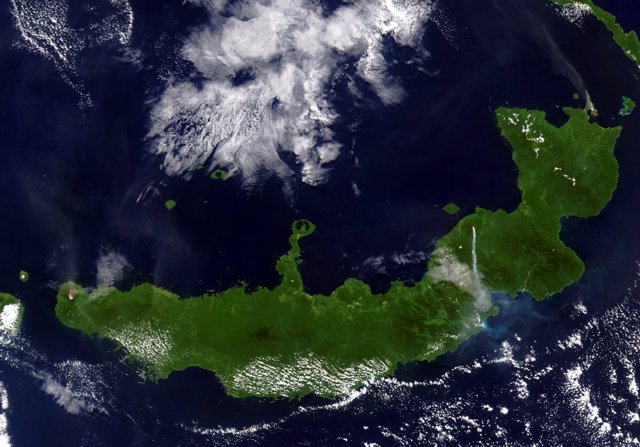Report on Ulawun (Papua New Guinea) — July 2005
Bulletin of the Global Volcanism Network, vol. 30, no. 7 (July 2005)
Managing Editor: Edward Venzke.
Ulawun (Papua New Guinea) Frequent ash/steam plumes during March-August 2005
Please cite this report as:
Global Volcanism Program, 2005. Report on Ulawun (Papua New Guinea) (Venzke, E., ed.). Bulletin of the Global Volcanism Network, 30:7. Smithsonian Institution. https://doi.org/10.5479/si.GVP.BGVN200507-252120
Ulawun
Papua New Guinea
5.05°S, 151.33°E; summit elev. 2334 m
All times are local (unless otherwise noted)
Long steam plumes during 22-23 August 2004 (BGVN 29:07) were observed on satellite imagery. Additional plumes were seen earlier that month, prompting the Darwin Volcanic Ash Advisory Center to issue advisories on four days.
Ulawun remained quiet from August 2004 until March 2005. During March 2005, weak to moderate volumes of thick white vapor were released from the main crater. On 27 and 28 March light gray emissions were observed, and small continuous volcanic tremor was recorded for six hours. The N vent remained quiet. Seismic activity continued at low levels with low-frequency earthquakes recorded. A tiltmeter was installed on 15 March but no significant movements were detected.
During April-July 2005 white vapor from the main vent was common, and plumes were frequently visible on satellite imagery. On 6 April, a thin plume was visible extending ~ 55 km to the SW. On 19 May a small plume to an unknown height extended W. Plumes to unknown altitudes were again released on 3 and 6 June. Plumes rising to 3 km altitude were seen on satellite imagery on 6 and 21 June. The 21 June plume contained ash, and initially extended W and WSW; imagery about six hours later showed the plume blowing NW. A short plume was visible at ~ 3 km altitude during 22-27 June, and on 27 June a pilot reported that the plume extended 37 km. During 30 June to 1 July, thin ash plumes were visible on satellite imagery, but heights were not given. No noise, night-time glow, or emissions were reported during this time. Small low-frequency earthquakes were recorded. Volcanic tremor was registered on 16-17 June.
On 9 August a plume drifting to the S was visible on satellite imagery (figure 10). During the rest of August, the summit crater released thick white vapor. Seismicity was characterized by small low-frequency earthquakes. One high-frequency earthquake and small periodic volcanic tremors were recorded.
Geological Summary. The symmetrical basaltic-to-andesitic Ulawun stratovolcano is the highest volcano of the Bismarck arc, and one of Papua New Guinea's most frequently active. The volcano, also known as the Father, rises above the N coast of the island of New Britain across a low saddle NE of Bamus volcano, the South Son. The upper 1,000 m is unvegetated. A prominent E-W escarpment on the south may be the result of large-scale slumping. Satellitic cones occupy the NW and E flanks. A steep-walled valley cuts the NW side, and a flank lava-flow complex lies to the south of this valley. Historical eruptions date back to the beginning of the 18th century. Twentieth-century eruptions were mildly explosive until 1967, but after 1970 several larger eruptions produced lava flows and basaltic pyroclastic flows, greatly modifying the summit crater.
Information Contacts: Ima Itikarai, Rabaul Volcano Observatory (RVO), P. O. Box 386, Rabaul, Papua New Guinea; David Innes, Air Niugini, PO Box 7186, Boroko, Port Moresby, National Capital District, Papua New Guinea (URL: http://www.airniugini.com.pg/); Darwin Volcanic Ash Advisory Centre (VAAC), Commonwealth Bureau of Meteorology, Northern Territory Regional Office, PO Box 40050, Casuarina, NT 0811, Australia (URL: http://www.bom.gov.au/info/vaac/).


